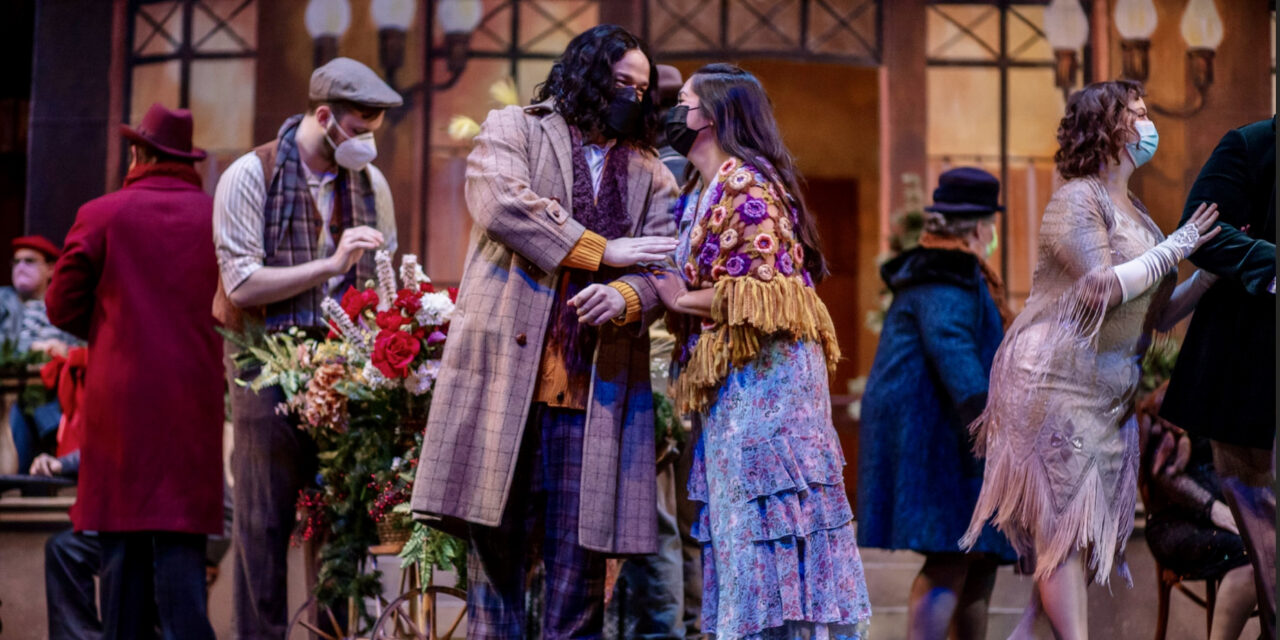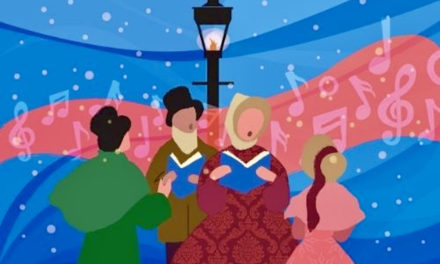(Above: La Bohème is the tragic tale of star-crossed lovers Rodolfo and Mimi. The Eugene Opera production features tenor Derrek Stark and soprano Vanessa Isiguen in the roles. Although rehearsals included pandemic-era masks, the performances won’t. Photos by Kelli Matthews.)
By Randi Bjornstad
The history
It’s not unusual for opera companies to produce favorite operas — their own and their audiences’ — multiple times, and Eugene Opera’s 2023 offering of La Bohème is no exception. The performances on Jan. 27 and 29 will be the sixth time for this tragic yet magical opera on the Eugene Opera stage — the others are Madama Butterfly and The Barber of Seville, with Carmen, The Mikado, and The Pirates of Penzance close behind with five times each.
That doesn’t mean that everything stays the same, of course, and this La Bohème will be different in several respects, according to stage director Nathan Troup.
“My responsibility is to help create or conceive an aesthetic for the production,” Troup said during a recent Zoom interview that also included conductor Andrew Bisantz, Eugene Opera executive director Erika Rauer, and Eugene Opera Orchestra principal oboist Cheryl Wefler.
His goal is to “converge the visual scenery and what the performers are doing,” Troup said, and the idea for this La Bohème is to advance the Parisian location by 100 years, from the original 1830s in which Giacomo Puccini set his tale of a poor embroiderer and her bohemian group of artistic friends.
“Even though the action is advanced a century, it addresses many of the same sets of circumstances,” Troup said. “Even with the difference in time, there still were many artistic people in the 1920s in the same situation — they were not flourishing financially, but they were carrying on their art and waiting for their turn to come.”
The physical setting for the opera also needs little adjustment, because the streets and buildings of Paris and many other ancient cities often haven’t changed much from one century to the next, and Troup suspects that probably in another hundred years there still will be garrets and gathering places where artists gather and exist together.
“Obviously there are shifts in social norms and gender constructs, but you really don’t have to change much to connect to this timeless story of dreams, suffering, mortality,” he said. “Fashions and trends change more than people and places, and this is the way this story is still told.”
The story
The plot of La Bohème is not complicated. It is based on a novel by Henry Murger, titled Scenes de la vie de bohème, about four young bohemians artists — musician (Schaunard), painter (Marcello), philosopher (Colline), and poet (Rodolfo) — who live together in straitened circumstances in the Latin Quarter of Paris.
One night, Rodolfo stays behind while the other three go out to eat, and when he answers a knock on the door, he opens it to a young woman named Mimi, whose candle has gone out and needs someone to relight it. Once inside, she faints, and as Rodolfo revives her, his candle also goes out. She has dropped her key as she fainted, and they search for it in the dark. Rodolfo finds it but does not say so because he is so taken by her. He touches her hand in the dark and tells her that he is attracted to her. They fall in love.
After some time, Mimi’s health has declined significantly, and although she and Rodolfo by then are living together, their relationship begins to fray, in part because of his fears about her health. She overhears a conversation during which Rodolfo tells Marcello of his unhappiness and his wish to end the relationship. Mimi becomes distraught, but the two agree to remain together until the spring. After they separate, their mutual friends Marcello and his lover, Musetta, also break off their relationship.
Months later, the four artists gather for a meal, and Musetta suddenly breaks into the room to announce that Mimi is on the stairs, too sick and weak to come up. Rodolfo carries her in and lays her on the bed. The others leave, and Rodolfo and Mimi recall their early, happier days. The others return and busy themselves preparing a meal when Schaunard realizes Mimi has died and alerts the others. Rodolfo rushes to her side.
The music
Conductor Andrew Bisantz acknowledges that many opera companies repeat their offerings often, but it happens in large part because of the love of the audience for the familiar stories and songs.
“Besides that, every production has something that makes it a new experience,” Bisantz said. “And major works like La Bohème have such dramatic import for audiences that they remain very popular.”
He is happy with this rendition of La Bohème and its “slightly reccontextualized” modernity, in large part because by this time there is little or no connection between modern audiences and the 1830s of Puccini’s opera, even though it remains a crowd favorite.
Bisantz chronicles the history of Eugene Opera, which dates to early 1977, when Carmen was its first production. During the 1977-78 season, the lineup included The Maid as Mistress, HMS Pinafore, and Don Giovanni, followed in 1978-79 by The Pirates of Penzance and The Barber of Seville.
“We did an analysis a couple of years ago, and basically for the first 15 years of Eugene Opera, everything was a ‘premiere,’ ” he said. “But by about 2007, almost all of the productions were repeats.”
Then, in the 2009-10 season, Eugene Opera stretched its wings with Nixon in China, along with some familiar crowd pleasers. It continued its avant garde presentation after that with selections such as Dead Man Walking, the story of Roman Catholic sister Helen Prejean and her ministry to people on death row. The opera composer was Jake Heggie, with libretto by playwright Terrence McNally, based on Prejean’s book, Dead Man Walking.
But whether old or new, traditional or edgy, Bisantz has one hope for the operas he conducts, “that we illuminate the story so that the actors interact with each other and are listening to each other and reviving what the (creators) of the opera intended.”
The cast
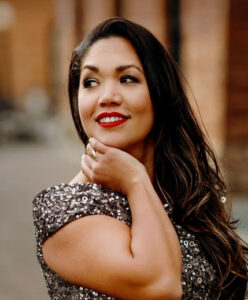
Vanessa Isiguen is Mimi
Of course, Bisantz continued, the biggest lesson in opera “all comes down to casting, with artists who are willing to work together to create details.”
Puccini’s operas are characterized by “a tightness — not a single note or word wasted,” he said. “And when we look at casting, we look at artists who have had success, but we also look around for people who have a particular ‘color’ to their voice, such as Mimi, who has a shimmering quality in her voice.”
Then there’s the practical matters, whether people are available or not, “but we have a good reputation — we can attract wonderful
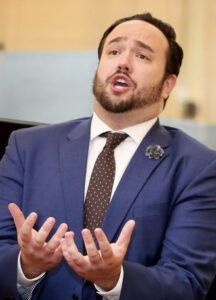
Derrek Stark is Rodolfo
artists who are world class,” Bisantz said.
With all those things in mind, the cast of this La Bohème features tenor Derrek Stark as Rodolfo and Vanessa Isiguen as Mimi.
Brooklyn Snow is Musetta, with Nicholas Davis as Marcello. Benjamin Brady takes the part of Colline, with Zachary Lenox as Schaunard and Doremus Scudder as Benoit/Alcindoro.
Then there are the sometimes unsung heroes of the cast, the members of the Eugene Opera Chorus and the Children’s Chorus, who “create a lot of vignettes on stage that increase the depth of the whole story,” Bisantz said.
The orchestra
Last, but definitely not least, is the orchestra in the pit right in front of the stage, who play the music that ranges from recent to centuries old. There too, Bisantz said, Eugene Opera’s reputation holds sway.
“The core orchestra for Eugene Opera is not as large as a symphony orchestra, but many musicians want to play for opera,” he said. “They change their schedules, they take time off from their jobs, they feel they are literally breathing with the singers they are accompanying, even though they can’t see them.”
Bisantz feels a similar thrill as he conducts opera.
“I not only get to conduct the concert, but also to see the dramatic scenario on the stage,” he said. “The conductor’s job is to be the fulcrum between the stage and the pit, to respond moment to moment so that the people onstage and the musicians are performing together.”
Because it’s live theater, timing among the performers onstage sometimes can vary, and voices may be a bit different from one performance to the next, and the conductor must “get that information to the orchestra,” Bisantz said.
For her part, Cheryl Wefler, the principal oboist for the Eugene Opera orchestra, says playing for opera “is the top of my list.”
It’s a completely different type of challenge, she said, needing not only to be expertly attuned to the music but also at interpreting what the go-between — the conductor — is signaling at any moment to keep the vocalists and the musicians together.
“The great hallmark of our orchestra is that the musicians play for many different groups in many different places, but they all want to come together here because they really want to do opera,” Wefler said. “And they know that training prepares you for almost everything, but that they have to be flexible — no opera ever goes exactly as planned.”
Eugene Opera performs La Bohème
When: 7:30 p.m. on Friday, Jan. 27, and 2:30 p.m. on Sunday, Jan. 29
Where: Silva Concert Hall, Hult Center for the Performing Arts, One Eugene Center (Seventh and Willamette streets), Eugene
Tickets: $15 to $79, available from the Hult Center box office, 541-682-5000, or online at eugeneopera.org or hultcenter.org
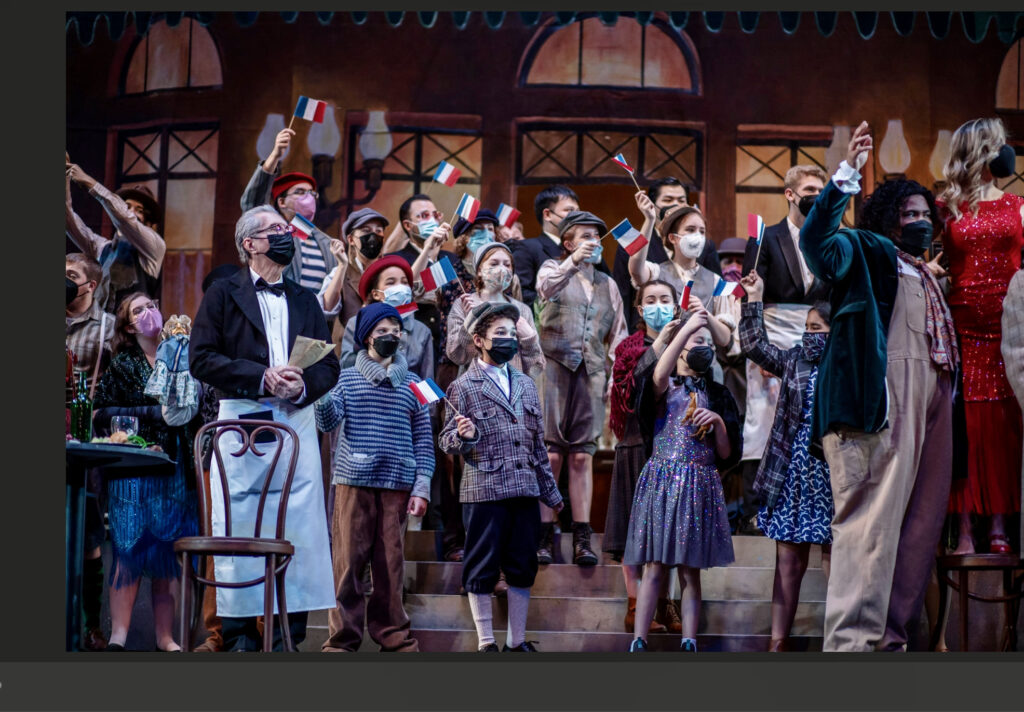
Crowd scene from La Bohème by Giacomo Puccini, Eugene Opera 2023; out of caution in the hopefully post-pandemic era, the performers wore masks for rehearsals of the classical opera but will not for the performances.

